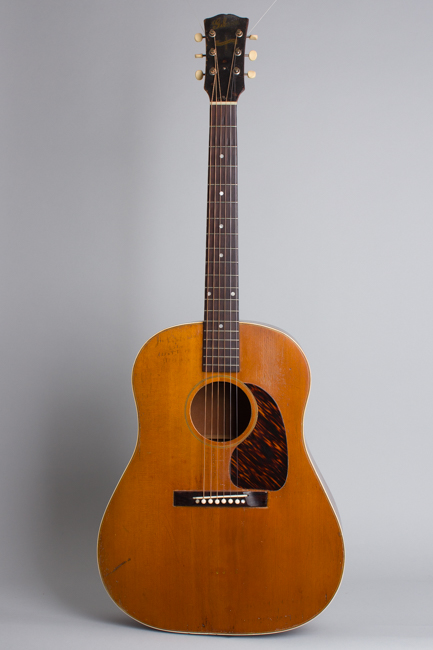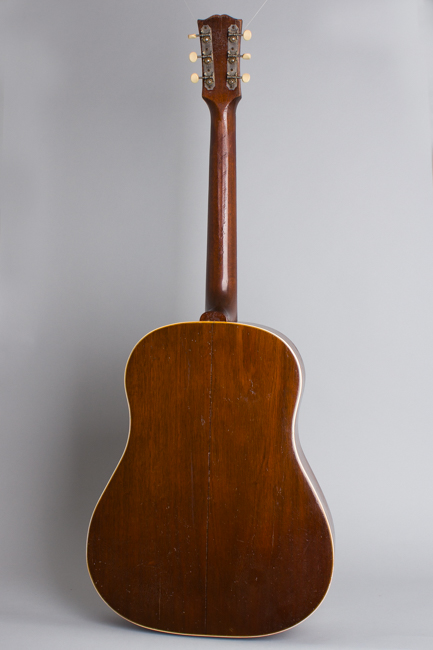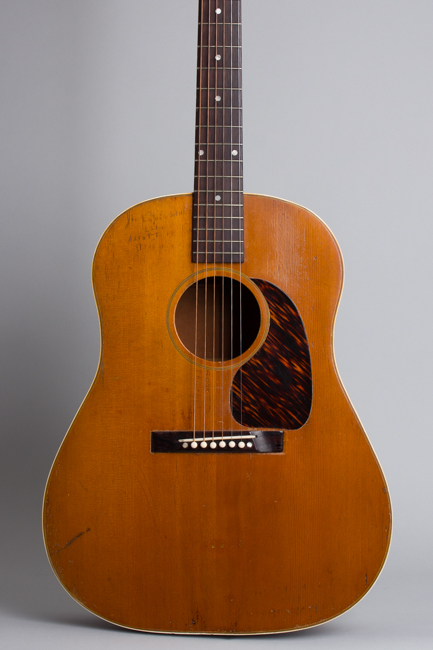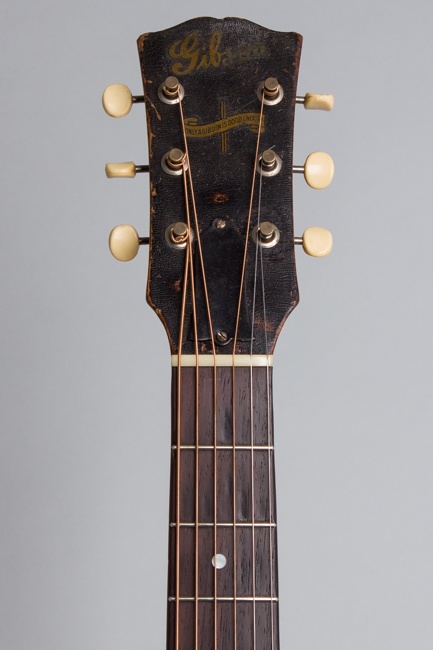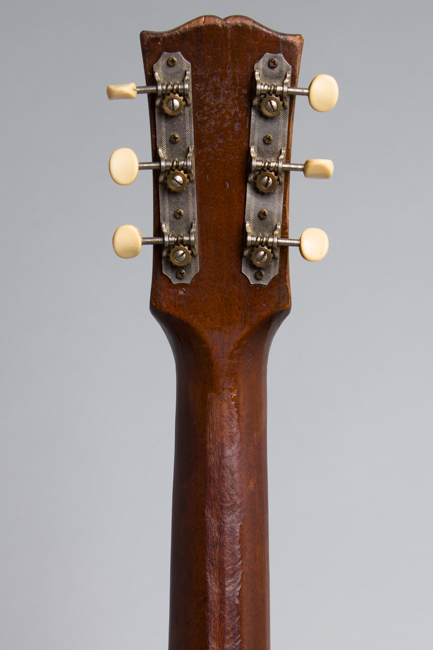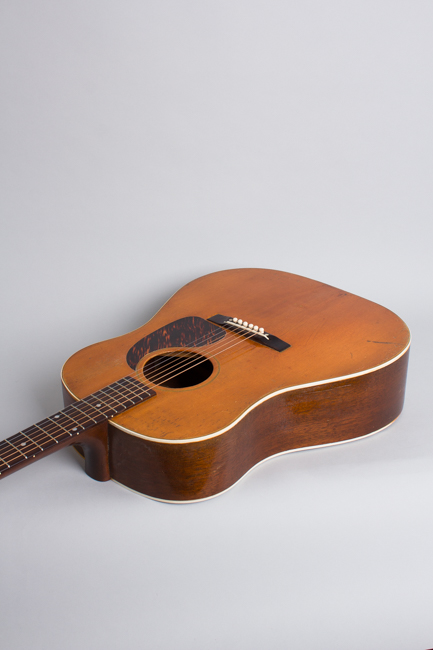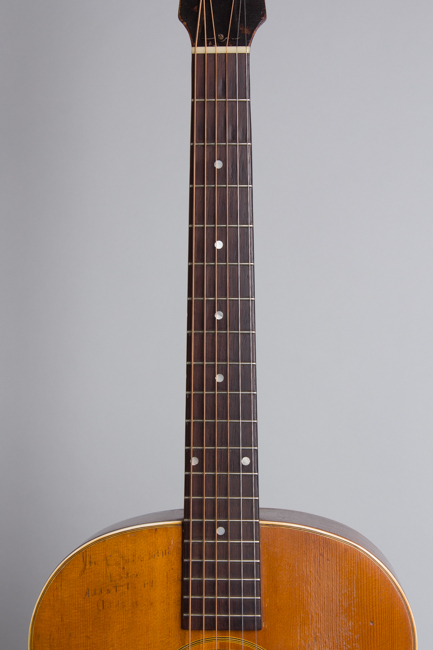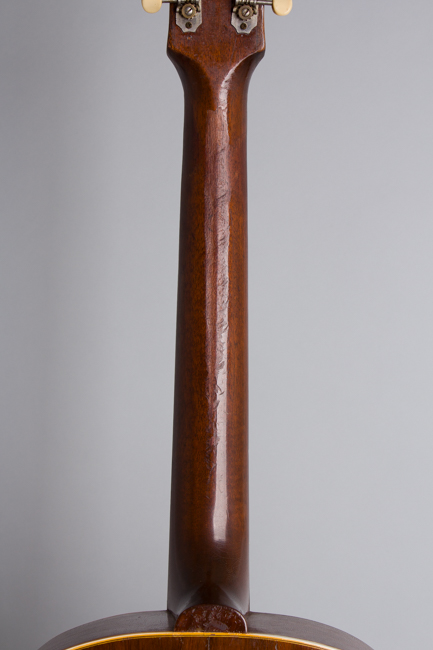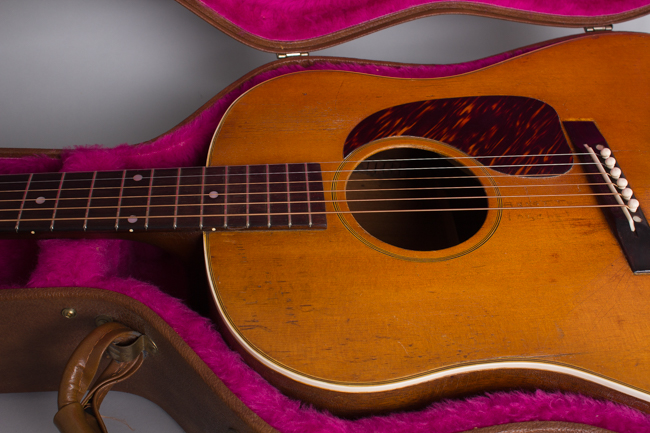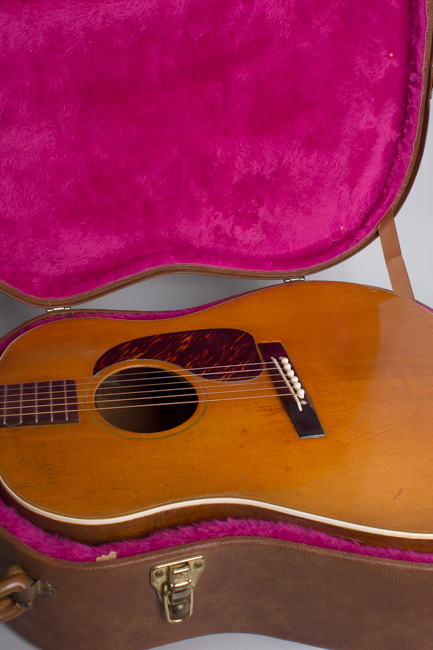Gibson J-50 Banner Acoustic Guitar (1942)
This item has been sold.
Item # 12144
Prices subject to change without notice.
Gibson J-50 Banner Model Acoustic Guitar (1942), made in Kalamazoo, Michigan, natural lacquer finish, mahogany back, sides and neck, spruce top, rosewood fingerboard, brown tolex hard shell case.
This heavily worn, weathered but beautiful Gibson J-50 is a very rare guitar, one of the earliest examples of this long-lived Jumbo model and also one of the very first "Banner" Gibsons ever built. The Factory Order Number (FON) 7117H on the heelblock identifies it as a 1942 model. The natural-top J-50 was actually the first model in the "Banner" line to go into production, and this early wartime J-50 has the earliest "Banner features". The first J-50 is registered as having been shipped out June 1, 1942 while the earliest J-45s and LG models were not shipped until August. This natural-top model was discontinued not too long after; only 144 total shipped out during the war, 98 during 1942 and a further 46 in 1943. the J-50 was revived
During the Second World War Gibson's instrument production was severely limited, and the specifications of individual instruments in this era can vary greatly, dictated by the materials available. This particular early guitar has the originally specified combination of a natural-finished spruce top over the mahogany back, sides and neck. The standard adjustable truss rod is installed; this feature was soon deleted as metal was severely rationed. The mahogany neck has a rosewood fingerboard and is shaped to a deep round profile, but not as bulky as some wartime guitars.
The soundhole rosette is the earlier 7-ply style, the top is 5-ply bound and the back 3-ply. The pickguard is the pre-war style "firestripe" celluloid, a very rare sight on a banner. The headstock bears the wartime gold script Gibson logo over the "Only a Gibson is Good Enough" banner decal that gives this era's guitars their identifying name. The back has a darker wood strip along the center seam and no internal back strip, another off short-lived feature. The main X brace and the two tone bars behind the bridge are all neatly scalloped. The Kluson strip tuners are just post-war style, upgraded from the slim war-era versions that appear in 1943.
This guitar has seen a lot of wear and repair and at least one good story, but remains is a great playing, huge sounding instrument. It has survived 80+ years in the field and kept on ticking, the one and only "Banner" J-50 we have ever had.
Overall length is 40 3/4 in. (103.5 cm.), 16 1/8 in. (41 cm.) wide at lower bout, and 4 3/4 in. (12.1 cm.) in depth at side, taken at the end block. Scale length is 24 3/4 in. (629 mm.). Width of nut is 1 11/16 in. (43 mm.).
This is a heavily used guitar, a "True Relic" in every sense of the word. There are a number of old repairs and some heavy wear but this is a solid and great sounding instrument. There is finish wear virtually everywhere; dings, dents, scrapes, and the like in profusion. The top has its own story to tell; under a VERY thin ancient varnish overcoat there are some words etched into the top lightly with pen or pencil. We can read the name "Annette Paschal" under the A string between the soundhole and bridge, and a faintly legible message on the upper bass bout by the edge. The previous owner deciphered it as "Joe Lewis Williams loves Annette Paschal, Texas" which gives this old Gibson more backstory mystery than most! The added thin coat of varnish over the top has micro-checked, and was applied so long ago most top wear is through it. This guitar shows less actual pick wear than many, mostly just a spot directly in front of the pickguard.
The top has two small repaired cracks off the back edge of the bridge, one behind the treble side running about 3" back and a short 1/2" off the bass side. There is a small grain spruce grain split off the bass side waist. There are two sealed grain splits to the back and some general finish disturbance; the back center seam appears resealed over part of its length. There are numerous repaired cracks on the sides, all previously sealed but some not lined up exactly. There are multiple cracks along the lower side leading to a mahogany patch repair to the curve of the lower treble bout side. This is neatly done, solid but visible with a notable thin refinish to that area only. The upper side has some small solidly sealed grain splits running back from the waist.
All the original slim scalloped top and back bracing remains intact including the small maple bridge plate with a couple of visible reglued spots to brace ends. The rosewood bridge is original, possibly slightly lowered ages ago but the retaining bolts and pearl dot caps are intact. The bridge has been reglued noticeably (probably more than once) and the bone saddle is newer. There is a lot of wear to the neck and headstock, including a "capo channel" worn in the back of the neck between the first and seventh fret positions. The neck has been cleanly reset some time back and neatly refretted with period appropriate wire showing hardly any wear. The tuners are later 1940s period Kluson strips with the original buttons.
This is a beautiful J-50 but not for the "clean freak"; still despite the wear and repairs this rare "Banner" Jumbo has survived in very playable and truly great sounding condition. This veteran J-50 has a huge ringing sound with considerable depth and power. If ever a guitar could be described as "ragged but right' this is it! It lives in a more recent Gibson HSC. Overall Very Good + Condition.
This heavily worn, weathered but beautiful Gibson J-50 is a very rare guitar, one of the earliest examples of this long-lived Jumbo model and also one of the very first "Banner" Gibsons ever built. The Factory Order Number (FON) 7117H on the heelblock identifies it as a 1942 model. The natural-top J-50 was actually the first model in the "Banner" line to go into production, and this early wartime J-50 has the earliest "Banner features". The first J-50 is registered as having been shipped out June 1, 1942 while the earliest J-45s and LG models were not shipped until August. This natural-top model was discontinued not too long after; only 144 total shipped out during the war, 98 during 1942 and a further 46 in 1943. the J-50 was revived
During the Second World War Gibson's instrument production was severely limited, and the specifications of individual instruments in this era can vary greatly, dictated by the materials available. This particular early guitar has the originally specified combination of a natural-finished spruce top over the mahogany back, sides and neck. The standard adjustable truss rod is installed; this feature was soon deleted as metal was severely rationed. The mahogany neck has a rosewood fingerboard and is shaped to a deep round profile, but not as bulky as some wartime guitars.
The soundhole rosette is the earlier 7-ply style, the top is 5-ply bound and the back 3-ply. The pickguard is the pre-war style "firestripe" celluloid, a very rare sight on a banner. The headstock bears the wartime gold script Gibson logo over the "Only a Gibson is Good Enough" banner decal that gives this era's guitars their identifying name. The back has a darker wood strip along the center seam and no internal back strip, another off short-lived feature. The main X brace and the two tone bars behind the bridge are all neatly scalloped. The Kluson strip tuners are just post-war style, upgraded from the slim war-era versions that appear in 1943.
This guitar has seen a lot of wear and repair and at least one good story, but remains is a great playing, huge sounding instrument. It has survived 80+ years in the field and kept on ticking, the one and only "Banner" J-50 we have ever had.
Overall length is 40 3/4 in. (103.5 cm.), 16 1/8 in. (41 cm.) wide at lower bout, and 4 3/4 in. (12.1 cm.) in depth at side, taken at the end block. Scale length is 24 3/4 in. (629 mm.). Width of nut is 1 11/16 in. (43 mm.).
This is a heavily used guitar, a "True Relic" in every sense of the word. There are a number of old repairs and some heavy wear but this is a solid and great sounding instrument. There is finish wear virtually everywhere; dings, dents, scrapes, and the like in profusion. The top has its own story to tell; under a VERY thin ancient varnish overcoat there are some words etched into the top lightly with pen or pencil. We can read the name "Annette Paschal" under the A string between the soundhole and bridge, and a faintly legible message on the upper bass bout by the edge. The previous owner deciphered it as "Joe Lewis Williams loves Annette Paschal, Texas" which gives this old Gibson more backstory mystery than most! The added thin coat of varnish over the top has micro-checked, and was applied so long ago most top wear is through it. This guitar shows less actual pick wear than many, mostly just a spot directly in front of the pickguard.
The top has two small repaired cracks off the back edge of the bridge, one behind the treble side running about 3" back and a short 1/2" off the bass side. There is a small grain spruce grain split off the bass side waist. There are two sealed grain splits to the back and some general finish disturbance; the back center seam appears resealed over part of its length. There are numerous repaired cracks on the sides, all previously sealed but some not lined up exactly. There are multiple cracks along the lower side leading to a mahogany patch repair to the curve of the lower treble bout side. This is neatly done, solid but visible with a notable thin refinish to that area only. The upper side has some small solidly sealed grain splits running back from the waist.
All the original slim scalloped top and back bracing remains intact including the small maple bridge plate with a couple of visible reglued spots to brace ends. The rosewood bridge is original, possibly slightly lowered ages ago but the retaining bolts and pearl dot caps are intact. The bridge has been reglued noticeably (probably more than once) and the bone saddle is newer. There is a lot of wear to the neck and headstock, including a "capo channel" worn in the back of the neck between the first and seventh fret positions. The neck has been cleanly reset some time back and neatly refretted with period appropriate wire showing hardly any wear. The tuners are later 1940s period Kluson strips with the original buttons.
This is a beautiful J-50 but not for the "clean freak"; still despite the wear and repairs this rare "Banner" Jumbo has survived in very playable and truly great sounding condition. This veteran J-50 has a huge ringing sound with considerable depth and power. If ever a guitar could be described as "ragged but right' this is it! It lives in a more recent Gibson HSC. Overall Very Good + Condition.
